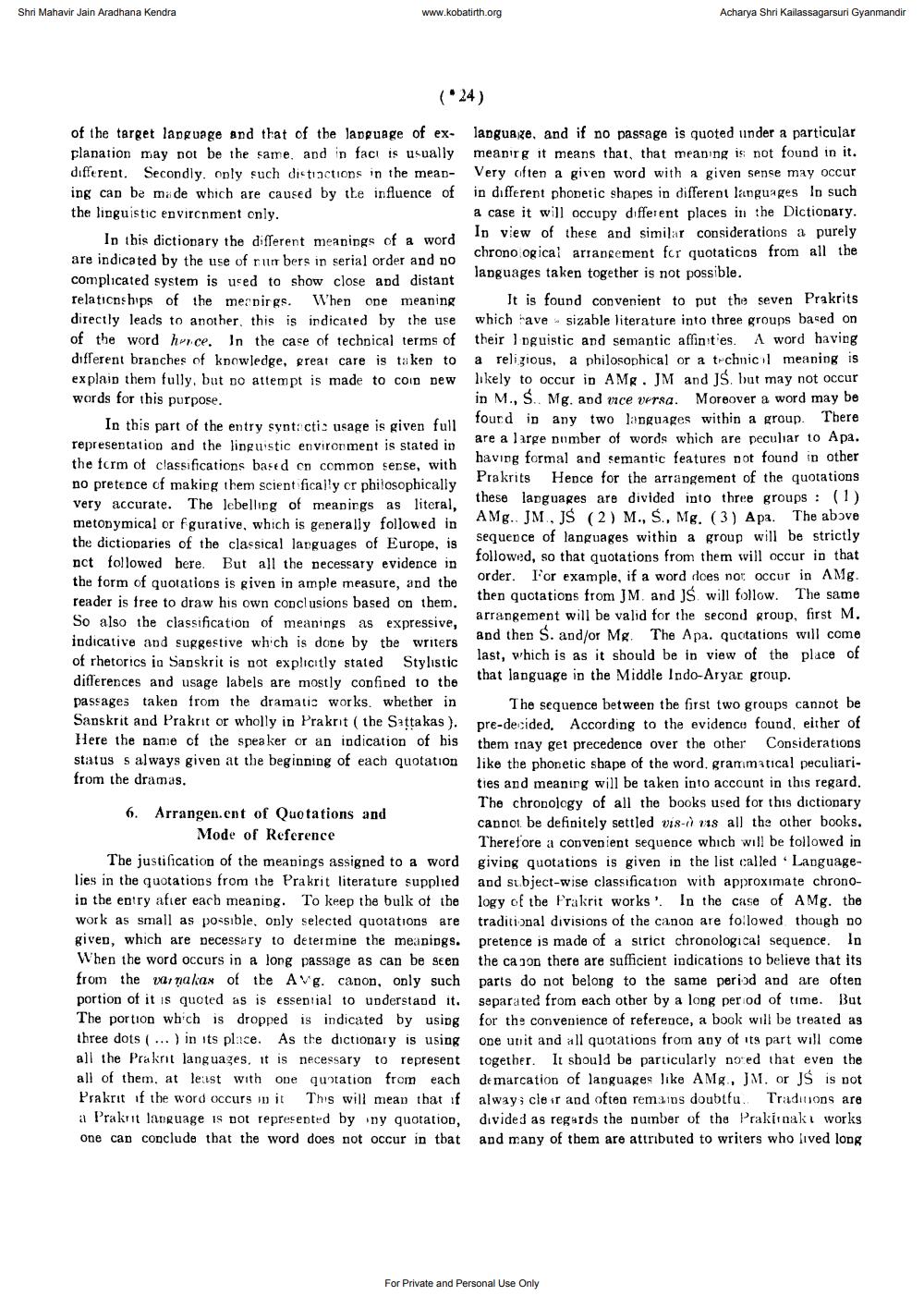________________
Shri Mahavir Jain Aradhana Kendra
www.kobatirth.org
Acharya Shri Kailassagarsuri Gyanmandir
(24)
of the target language and that of the language of ex- language, and if no passage is quoted under a particular planation may not be the same, and in fact is usually meaning it means that, that meaning is not found in it. different. Secondly, only such distractions in the mean- Very often a given word with a given sense may occur ing can be made which are caused by the influence of in different phonetic shapes in different languages In such the linguistic environment only.
a case it will occupy different places in the Dictionary. In this dictionary the different meanings of a word
In view of these and similar considerations a purely are indicated by the use of rubers in serial order and no
chrono ogical arrangement for quotaticos from all the complicated system is used to show close and distant
istant languages taken together is not possible. relationships of the medir gs. When one meaning It is found convenient to put the seven Prakrits directly leads to another, this is indicated by the use which have sizable literature into three groups based on of the word hunce. In the case of technical terms of their lnguistic and semantic affin t'es. A word having different branches of knowledge, great care is taken to a religious, a philosophical or a trchnicil meaning is explain them fully, but no attempt is made to coin new likely to occur in AMg. JM and JS. but may not occur words for this purpose.
in M., S. Mg.and mice versa. Moreover a word may be In this part of the entry syntactic usage is given full
fourd in any two languages within a group. There representation and the linguistic environment is stated in
are a large number of words which are peculiar to Apa. the form of classifications based on common sense, with
having formal and semantic features pot found in other no pretence of making them scientifically cr philosophically
Prakrits Hence for the arrangement of the quotations very accurate. The lebelling of meanings as literal,
oral these languages are divided into three groups : (1) metonymical or fgurative, which is generally followed in
AMg. JM, JS (2) M., S., Mg. (3) Apa. The above the dictionaries of the classical languages of Europe, is
sequence of languages within a group will be strictly nct followed here. But all the necessary evidence in
followed, so that quotations from them will occur in that the form of quotations is given in ample measure, and the
order. For example, if a word does not occur in AMg. reader is free to draw his own conclusions based on them.
then quotations from JM. and JŚ, will follow. The same So also the classification of meanings as expressive,
arrangement will be valid for the second group, first M. indicative and suggestive which is done by the writers
and then S. and/or Mg. The Apa. quotations will come of rhetorics in Sanskrit is not explicitly stated Stylistic
last, which is as it should be in view of the place of differences and usage labels are mostly confined to the
that language in the Middle Indo-Aryar group. passages taken from the dramatic works. whether in The sequence between the first two groups cannot be Sanskrit and Prakrit or wholly in Prakrit (the Sattakas). pre-decided. According to the evidence found, either of Here the name of the speaker or an indication of his them inay get precedence over the other considerations status s always given at the beginning of each quotation like the phonetic sbape of the word, grammatical peculiarifrom the dramas.
ties and meaning will be taken into account in this regard.
The chronology of all the books used for this dictionary 6. Arrangen.ent of Quotations and
cannot be definitely settled vis-1 118 all the other books. Mode of Reference
Therefore a convenient sequence which will be followed in The justification of the meanings assigned to a word giving quotations is given in the list called Languagelies in the quotations from the Prakrit literature supplied and subject-wise classification with approximate chronoin the entry after each meaning. To keep the bulk of the logy of the frakrit works'. In the case of AMg. the work as small as possible, only selected quotations are traditional divisions of the canon are followed though no given, which are necessary to determine the meanings. pretence is made of a strict chronological sequence. In When the word occurs in a long passage as can be seen the canon there are sufficient indications to believe that its from the viinakas of the Avg. canon, only such parts do not belong to the same period and are often portion of it is quoted as is essential to understand it. separated from each other by a long period of time. But The portion which is dropped is indicated by using for the convenience of reference, a book will be treated as three dots (...) in its place. As the dictionary is using one unit and all quotations from any of its part will come all the Praknit languages, it is necessary to represent together. It should be particularly noted that even the all of them, at letst with one quotation from each de marcation of languages like AMg., JM, or JS is not Prakrit of the word occurs w it This will mean that if alway; cle ir and often remains doubtfu. Traduons are a Prakrit language is not represented by my quotation, divided as regards the number of the Prakirnakt works one can conclude that the word does not occur in that and many of them are attributed to writers who lived long
For Private and Personal Use Only




